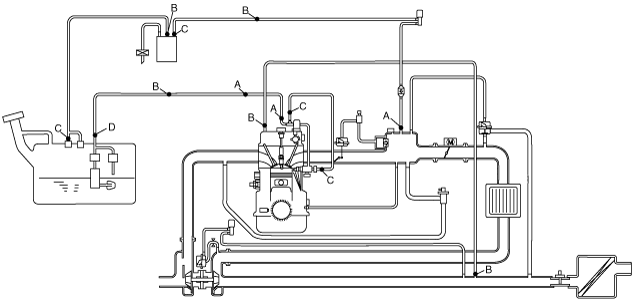QUICK RELEASE CONNECTOR CONSTRUCTION/OPERATION[L3 Turbo]
id0114b4102300
• There are four types of quick release connectors.
Quick release connector locations
Type A
• Used in the engine compartment.
• An SST is not used with this type.
• Mainly consists of a retainer and O-ring. The quick release connector is integrated with the fuel hose and therefore cannot be disassembled.
• When the quick release connector is connected, the fuel pipe projection is locked at the clamp lock point. By pushing the clamp release tab to expand the clamp, the lock point is released allowing the fuel pipe to be disconnected.
|
1
|
Quick release connector
|
|
2
|
Release tab
|
|
3
|
Lock point
|
• To connect the quick release connector properly, push it into the fuel pipe until a locking click sound is heard.
• New quick release connectors are fitted with a checker tab that prevents improper fit. This checker tab cannot normally be removed. When the quick release connector is properly connected to the fuel pipe, the lock is released and the checker tab comes off. Due to this, it can be verified that the quick release connector is completely connected.
|
1
|
Fuel pipe
|
|
2
|
Checker tab
|
Type B
• Used on the fuel tank side of the charcoal canister.
• When removing the quick connector, either of the 2 types of SSTs can be used.
|
1
|
Fuel pipe
|
|
2
|
Quick release connector
|
• The connector can be disconnected by pinching the retainer tab with the SST and pulling the connector.
• To connect the quick release connector properly, push it into the fuel pipe until a locking click sound is heard.
• New quick release connectors are fitted with a checker tab that prevents improper fit. This checker tab cannot normally be removed. When the quick release connector is properly connected to the fuel pipe, the lock is released and the checker tab comes off. Due to this, it can be verified that the quick release connector is completely connected.
|
1
|
Checker tab
|
|
2
|
Fuel pipe
|
Type C
• Used on the fuel tank side of the charcoal canister, rollover valve and in the engine compartment.
• An SST is not used with this type.
• Mainly consists of a retainer and O-ring. The quick release connector is integrated with the fuel hose and therefore cannot be disassembled.
• The fuel pipe can be disconnected by moving a retainer upward using a small flathead screwdriver or a similar tool.
|
1
|
Flathead screwdriver
|
|
2
|
Retainer
|
|
3
|
Quick release connector
|
• The properly connected the quick release connector, inserting it deep into the fuel pipe and push down on the retainer with your finger.
• New quick release connectors are fitted with a checker tab that prevents improper fit. This checker tab cannot normally be removed. When the quick release connector is properly connected to the fuel pipe, the lock is released and the checker tab comes off. Due to this, it can be verified that the quick release connector is completely connected.
|
1
|
Quick release connector
|
|
2
|
Retainer
|
|
3
|
Fuel pipe
|
|
4
|
Checker tab
|
Type D
• Used on the fuel pump.
• Mainly consists of a retainer and O-ring. The quick release connector is integrated with the fuel hose and therefore cannot be disassembled.
• An SST is not used with this type.
• By pushing the release tab of the retainer, the lock point is released allowing the fuel pipe to be disconnected.
|
1
|
Quick release connector
|
|
2
|
Release tab
|
|
3
|
Fuel pipe
|
• To connect the quick release connector properly, push it into the fuel pipe until a locking click sound is heard.
